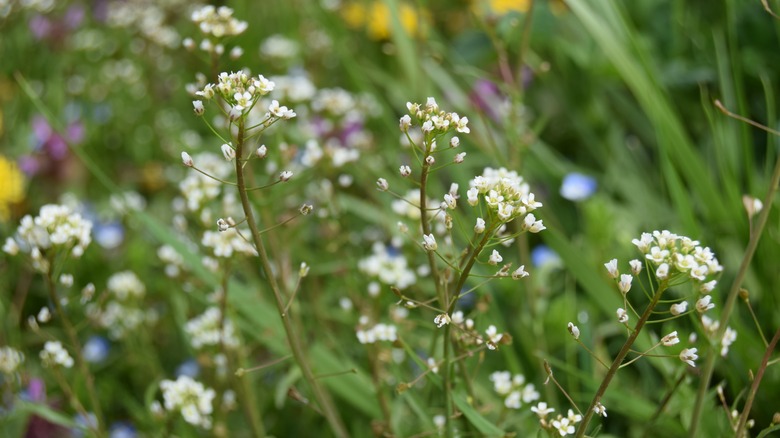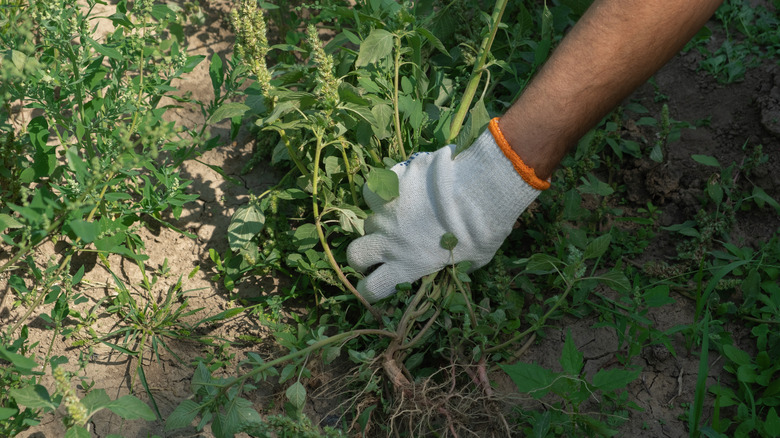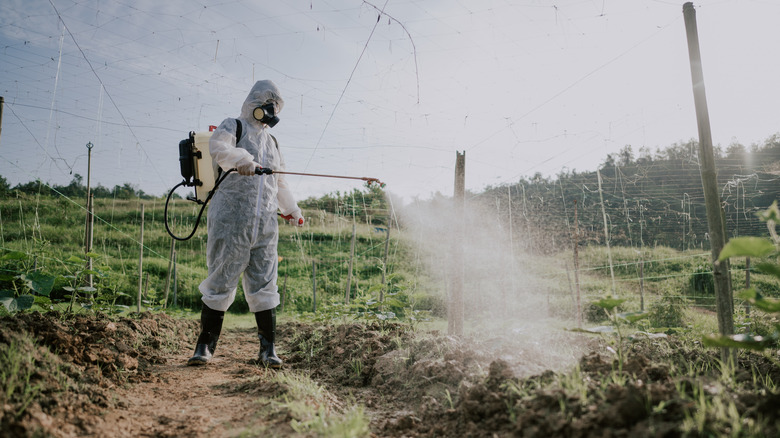How To Handle Shepherd's Purse In Your Lawn
Shepherd's purse, or Capsella bursa-pastoris, is a flowering plant that's part of the mustard family. You'll recognize it by its rosette of basal leaves, small white flowers, and, as it matures, purse-shaped seed pods that grow along erect stems. You might find Shepherd's purse to be an aggressive weed that, at some point, will need to be removed. You have two primary removal options: manually pulling it out or opting for herbicides. Each method has its own advantages, and your choice will hinge on various factors, such as how widespread the infestation is, your comfort level with using chemicals, and the specific conditions of your lawn.
Before choosing a method, remember that this unassuming little plant can increase rapidly, producing numerous seeds capable of surviving a range of conditions. If left unchecked, shepherd's purse can transition from being a harmless, or even beneficial, member of your garden to a problematic weed that competes aggressively with your desired plants for nutrients, water, and sunlight. Its quick life cycle allows it to adapt and spread, making it a challenging weed to control. Due to its resilience and adaptability, addressing a shepherd's purse problem in your lawn is critical as soon as it's identified.
Going hands-on with weeds
When grappling with a shepherd's purse problem in your lawn, one effective way to tackle it is by pulling the weeds out manually or using a specialized weed-removal tool. This is a particularly convenient option for several reasons. First, hand-pulling works quite well with shepherd's purse due to its specific growth characteristics. This weed typically has a relatively shallow root system, making mechanical removal far less troublesome than weeds with deeper, more complex root systems. This specific trait means that you won't need to expend as much effort, energy, or time in the removal process. In addition, targeting new or young growth is highly effective for these shallow-rooted weeds, allowing for easier, quicker eradication before they mature and proliferate.
While you're engaged in this activity, it's wise to minimize soil disruption as much as possible. Gently uproot the young sprouts to ensure you're eliminating these new seedlings from the top layer. A gentle touch helps to keep inactive seeds buried, reducing the chance of future outbreaks. To make your garden weed-removal efforts even more effective, consider applying a 2-inch layer of composted garden waste or bark mulch around your plants. And for an extra layer of prevention, you could place a weed barrier cloth beneath the mulch. This cloth will act as an additional obstacle, making it more difficult for any lurking seeds to sprout and establish themselves, thus providing you with a more long-term solution.
Herbicidal solutions for persistent weeds
If an infestation of shepherd's purse is widespread, the pulling-out method may not be enough. In such cases, herbicides can be your weapon of choice. If you decide to go down this path, picking the right solution for the job is crucial. Consider spot-treating shepherd's purse with iron-based solutions such as Barricade weed control. These products have been found to be particularly effective against this pesky invader. If you're looking for broader options, products with active ingredients like MCPP, Triclopyr, Dicamba, or 2-4-D are generally the most potent choices against shepherd's purse.
Timing, as they say, is everything. The ideal time to unleash these herbicides is during the mild temperatures of the spring or fall. The key is to target young, actively growing shepherd's purse plants. This ensures that the chemicals are absorbed effectively, disrupting the weed's growth process. However, one application might not guarantee complete eradication. Multiple follow-up treatments may be required thereafter, as is necessary when eliminating weed. This will deal with any resilient plants or new growth that might have sprung up in the interim. But as with any chemical application, reading and strictly adhering to the product's label is paramount. Also, note that while herbicides are powerful, those containing dicamba should be applied with care since they can also pose a risk to other desirable plants. Also, try to avoid using them close to the root zones of trees and shrubs.


